ASA synthetic resin tiles, as a new type of roofing material, are widely used in factory renovations and rural villa construction due to their advantages, such as anti-aging, anti-ultraviolet, anti-corrosion, anti-freezing, insulation, heat insulation, and flame retardancy. However, in recent years, quality problems of synthetic resin tiles have been frequent.

The reasons for the price differences of synthetic resin tiles:
1. Quality differences of ASA synthetic resin
ASA resin, as one of the key materials for resin tiles, has excellent UV resistance and anti-aging properties. However, the prices of ASA vary widely by quality: high-quality ASA can reach 4,000 US dollars per ton, while low-quality ASA may be as low as 1,000 US dollars per ton. Resin tiles made with inferior ASA exhibit poor anti-aging performance, are prone to fading, and have a greatly shortened service life.
2. Adjustment of thickness
The thickness of synthetic resin tiles directly affects their strength and durability. Some manufacturers cut costs by reducing the thickness, for instance, by making 3.0mm thick tiles 2.8mm thick. However, this approach will lead to a reduction in the strength and durability of the resin tiles, affecting their usage.
3. The quality of PVC raw materials
PVC is another major material for synthetic resin tiles, and its price directly affects the overall quality of the resin tiles. Some manufacturers may use recycled PVC (recycled material), which not only has poor quality but also fails to meet the standards for anti-aging and durability.

4. Differences in the proportion of raw materials
In the production of synthetic resin tiles, the proportion of raw materials is of vital importance. Some unscrupulous manufacturers reduce production costs by using a large amount of cheap calcium carbonate (calcium powder) or plasticizers. Calcium carbonate is inexpensive, but excessive use can affect the strength and durability of resin tiles. The plasticizer will evaporate within a short period of time, causing the tiles to crack and lack good fire resistance.
5. Use ABS instead of ASA
Some manufacturers use ABS (acrylonitrile butadiene-styrene) to replace high-performance ASA resin in order to cut costs. ABS material is inexpensive, but its anti-aging performance is much worse than that of ASA. It has a short lifespan and is prone to fading and cracking, which affects the long-term usage effect of resin tiles.
6. Production processes and other costs
The production processes, factory rent, labor costs and water and electricity expenses of each manufacturer are different, which will also directly affect the price of resin tiles. Some manufacturers reduce the cost per piece through large-scale production, thus making their product prices more competitive.




